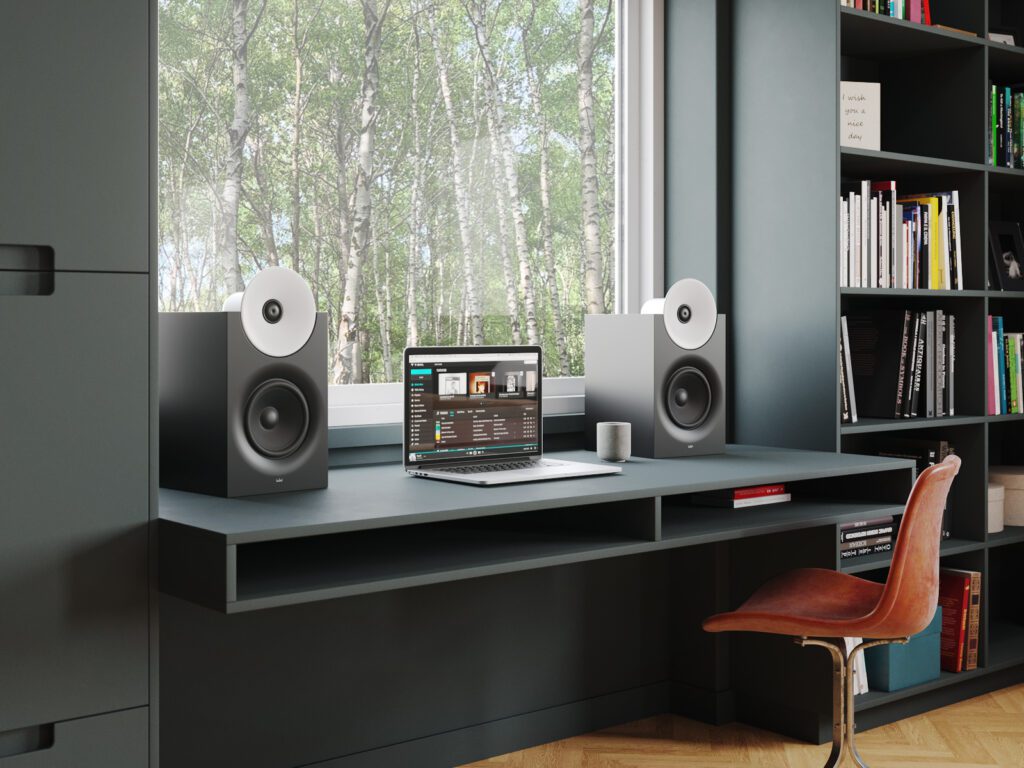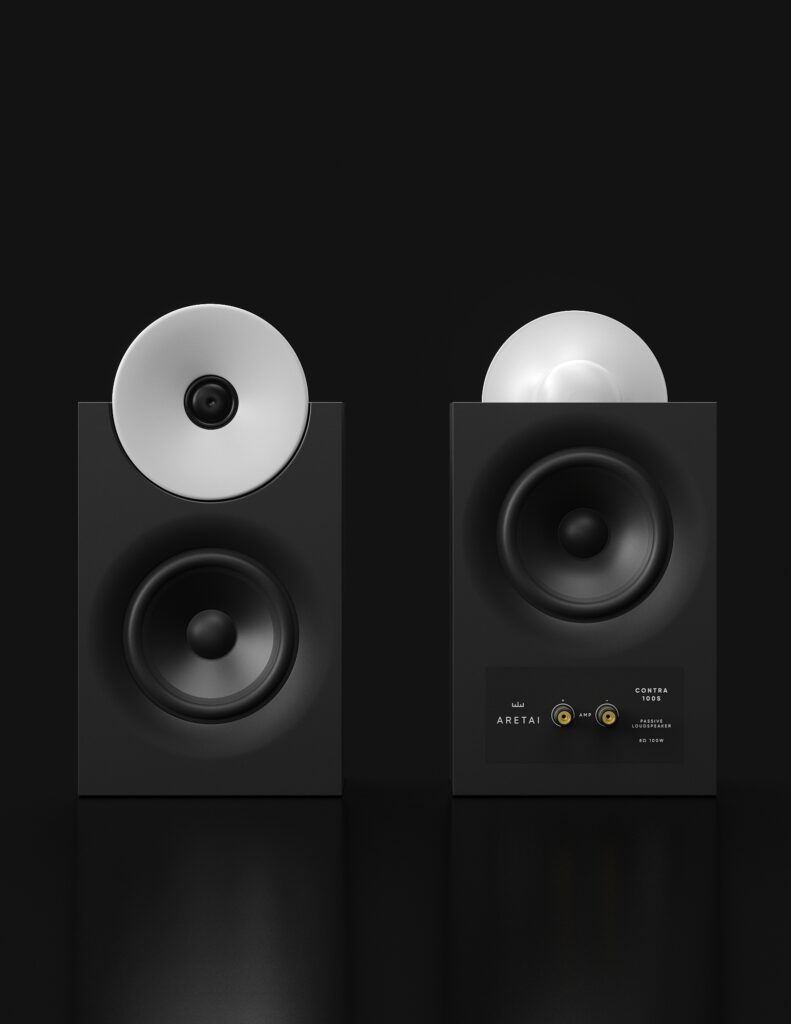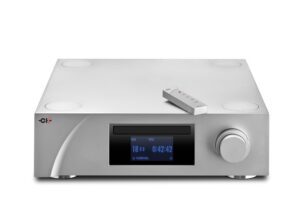
The Hanseatic League was a form of proto–European Union that started in the mid fourteenth century and lasted for over 300 years (I wonder if the current one will last as long). It was formed by cities in Germany and around the Baltic Sea and stretched from Bruges right round to Turku in Finland and Bergen in Norway and created for trading purposes; the cities involved have remained wealthy to this day. One of them is Riga in Latvia and this is where loudspeaker maker Aretai is based.
The Contra 100S is Aretai’s only bookshelf speaker and the entry-level model in a three-strong range where all the models are distinguished by a white tweeter horn sitting on top of a contrasting black cabinet. On the Contra 100S, this horn is 157mm (about six inches) in diameter and the way it’s built into the top of the otherwise rectilinear cabinet is particularly well done. It looks as though there is a channel carved out of the flat top of the box in which the back of the horn sits; a job that would have been easier to achieve by cutting the cylindrical horn body in half and placing it atop the box. But this is why when you glance at the price and size of this speaker it looks a little ‘spendy’, but the detailing is perfect across the board and some of the details are not immediately apparent.
Back and front
The first thing you spot when looking around it is that there is another driver on the back which is identical to the front firing cone. It turns out that this is the bass driver in a two-and-a-half-way sealed box design. Both drivers sit in a shallow horn achieved by machining the MDF if that’s what it is, the Aretai website is rather scant on detail for such a detail obsessed company. The company must be ‘young’ because there’s more info on social media and thankfully the distributor Val Hi-Fi has the specs to hand.
The Contra 100S has a built-in plinth that angles the cabinet upwards but is separated by a vibration decoupling pad that provides a degree of isolation from whatever surface it sits on. This could be a speaker stand or a desktop according to Aretai who would probably like to get this speaker into studios among other places but show them on a (presumably) quite large desk in some of their literature.

The horn that surrounds the tweeter was developed to aid dispersion and increase sensitivity but is shallow to avoid the negative characteristics found with some conventional horns, such as beaming and a cuppiness. The tweeter itself is a large ring radiator type that could theoretically be used down to around 2.5kHz but Aretai founder/designer Jānis Irbe has put the crossover point much higher at around 6kHz. He has however allowed tweeter and the mid/bass unit below it to roll off gently so that there is more overlap between the two than usual. The mid/bass and bass drivers are six inches in diameter and run polypropylene cones, I’m told that they were selected for their “extremely low THD and IMD distortion values and very smooth breakup characteristics”.
Jānis’ background is in IT, but he clearly has had the hi-fi bug for a long time and spent seven years researching the ‘virtues’ of the perfect loudspeaker before launching the company in 2018. The name comes from Aretaic theory, which argues that laws should be created that bring out human virtues. This seems like a good idea if a bit challenging to execute effectively.
Jānis has come up with a (figurative and literal) sound concept to encompass what he is trying to achieve with Aretai, and this includes purity of sound and minimal yet expressive design where sound follows form, room energising sound at that. He agrees with PMC and others when it comes to direct and indirect sound, since both need to be the same if the sum that you hear is to be coherent. That is the sound that hits the room boundaries before it gets to your ears should have the same balance as that which has a direct path. Another laudable point that Jānis makes is that Aretai products are sustainable; making them largely out of wood goes a good way toward that goal, as does the use of purely cardboard packaging.
The overall sensitivity of the Contra 100S is 85dB with a four Ohm impedance so it’s not the most efficient of designs, but Jānis says that good results can be had with a range of amplifiers including single ended triodes, although solid-state amps will naturally get the best bass performance from them. The cable terminals are high quality single wire types as standard, but the option exists to have tri-wire terminals for those looking for maximum control.
There are various finish options too including veneer in matte or gloss finish, but the black paint finish contrasts particularly well with the white horn.
Sound quality
UK distributor Greg Chapman of VAL Hi-Fi brought the Contra 100S over with a pair of Solid Steel SS-5 three-legged stands which he said are a little short for my listening position, but he likes the way the speakers sound on them. Listening started with the Aretai being driven by a Moor Amps Angel 6 power amplifier with the speakers placed about a foot from the wall which worked well for the mid and treble, but the bass was a little boxy on some tracks. That said Joni Mitchell’s voice sounded rather good on ‘The Man I Love’ and the bass on Kraftwerk’s ‘Radioactivity’ had more gravitas than expected for a box of this scale, the reverb on the live mix giving real depth to the soundstage. Moving the Aretai closer to the wall meant that the soundstage got bigger, but the bass didn’t really change which was surprising, having an active rear bass driver clearly brings benefits in terms of control. Deadmau5’s ‘Seeya’ was delivered with real spatial precision at high levels without any sense of glare or hardness, a characteristic that was to become more apparent the further the listening went on. Aretai favour pro drivers which are generally designed to cope with higher playback levels without distortion and this certainly came through.

To get more mid and treble from the Contra 100S I put them on some higher 60cm stands from Custom Design, my listening seat is a little higher than average and this stand brought notable improvements in image precision. The scale and depth that the Aretai found on a number of albums was impressive but Brokeback’s Looks at the Bird was particularly good in this respect, with the bass and electric guitars sounding unusually articulate with plenty of low-level detail. Crosby, Stills and Nash’s ‘Helplessly Hoping’ didn’t have as much scale as I expected but this is probably a realistic reflection of the recording whose strength lies in its tonal beauty as much as the quality of performance. Massive Attack’s ‘Man Next Door’ has become a go to for assessing bass extension and power and these relatively compact speakers delivered more weight than most thanks to that active rear bass driver. But it’s the mid and treble that provide the powerful sense of presence in the vocal, something that’s not affected by the deep thump of the drum and the general air of menace that the band managed to capture so effectively.
The bass is also pleasingly tuneful and strong, the Grateful Dead’s ‘Cumberland Blues’ is a fabulous live track, but the bass line frequently gets lost in the organised mayhem that erupts when the singing stops and two guitarists, a pianist and a drummer get busy. It can usually be heard if you make the effort but often gets masked by louder sounds, this was not the case with these black and white beauties, they give you the depth and the power that many other speakers seem unable to find in the recording. This could be because they were a little close to the wall and the bass was reinforced but whatever the reason the result was rather good, especially if you wind up the wick. My chamber music piece of the moment, which has become quite a long moment I realise, is the Engegård Quartet’s take on Haydn’s String Quartets which these speakers reproduced in an attractively natural fashion, placing the musicians behind the cabinets and providing a perspective that was wholly convincing. A more recent recording of the eight strong Locrian Ensemble made by Mike ‘Chasing the Dragon’ Valentine on valve mics in front of the editor and myself was a lot more relaxed and open, getting close to the result we heard in the Henry Wood Hall a couple of weeks earlier. Which given how good it sounded there is an achievement of note.
Again imaging was a highpoint with this piece, these speakers gave a good sense of the scale of the location and likewise of the instruments being played which were modern rather than ‘original’ as is often the case with chamber pieces. Comparing the Aretai with an admittedly more affordable pair of speakers was a bit like contrasting an oil painting with a cartoon. There is a depth of detail that is very agreeable and this is apparent with pretty well any type of music.
I also tried a lower powered amplifier in the form of Rega’s Elex-R integrated, which while a little bit too affordable to be a likely partner for the Aretai does have many excellent qualities and not just for its price. One of them is excellent communication skills which these speakers were more than happy to exploit when Nina Simone is on the turntable, her voice on ‘’Don’t Smoke in Bed’ is perfect, full of feeling and sad beauty. This despite the dual mono nature of this particular version making it sound even older than it is. I played quite a lot of vinyl through a couple of phono stages and the Aretai made it absolutely clear that there were significant differences between them. One being warm and relaxed and the other distinctly more focussed and precise, as ever when presented with two extremes like this the tendency is to want something in between. Such is the odious nature of comparisons.

Playing vinyl through these monochrome speakers was a very enjoyable experience however, Ryley Walker’s ‘I Will Ask You Twice’ being deliciously relaxed, warm and inviting through them, which encouraged further listening of this and many other albums. The acoustic guitars and voice being the standout elements thanks to the effortless nature of the Aretai’s midrange and treble. This is in many ways the key strength of these speakers, their ability to deliver detail, extension and scale in a relaxed fashion from a compact enclosure. It means that they will lay down a banging beat in powerful fashion without becoming aggressive or losing coherence and that live recordings can be reproduced in surprisingly convincing fashion if said recordings are of a high enough calibre. Ryan Adams encourages fans (if he still has any – Ed) to record his concerts in much the same way that the Grateful Dead did, and many of them can be found on the Archive website. One in particular, Live at Das Haus, is exceptional and with a speaker like this fills the room with energy and sound to fabulous effect. It makes you wonder why more official releases aren’t as good.
Conclusion
Aretai has its own take on loudspeaker design and aesthetics. The use of a shallow horn allows the tweeter to deal with higher sound pressures without difficulty and the use of two bass drivers gives what is a fairly compact box more low end fire power than usual. They are a little more tricky to position than average as a result of that rear driver and need more space than similarly sized bookshelf models but the resulting sound is attractively easy on the ear. Combine this with the appealingly post modern styling of the Contra 100S and you have a loudspeaker that’s ready to make its mark in a competitive market.
Technical specifications
- Type 2.5-way, three-driver stand-mount monitor with infinite baffle enclosure
- Driver complement One 45mm tweeter, one 150mm mid-bass driver, 150mm bass driver
- Frequency response 32Hz–30kHz
- Crossover frequency 6kHz
- Impedance 4 Ohms
- Sensitivity 85dB/W/m
- Dimensions (H×W×D) 420 × 214 × 250mm (including plinth)
- Weight 15kg/each
- Finishes black semi-matt enclosure finish with pearl white waveguide
- Price £7,250 per pair
Manufacturer
Aretai
URL: aretai.com
Tel: +371 2922 3823
UK Distributor
VAL HiFi
+44(0)333 577 2005
By Jason Kennedy
More articles from this authorRead Next From Review
See all
PrimaLuna EVO 100 phono preamplifier
- Apr 22, 2024

Reiki Audio SuperSwitch Master Pro + Servant Pro
- Mar 27, 2024

Melco Audio N1-S38 music server
- Mar 27, 2024











